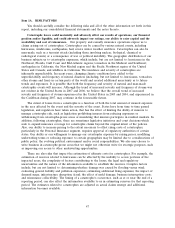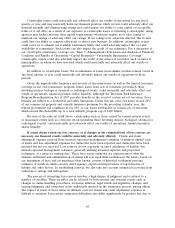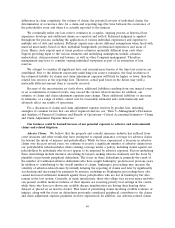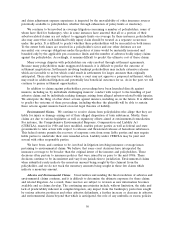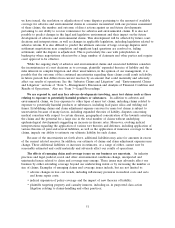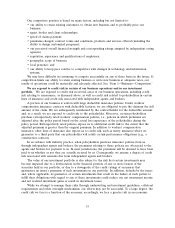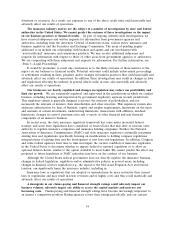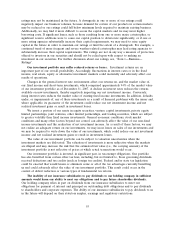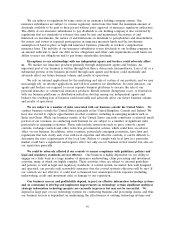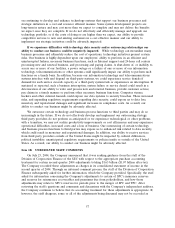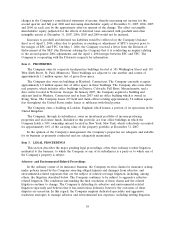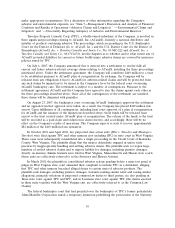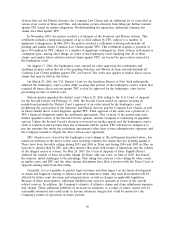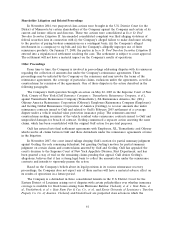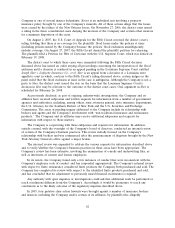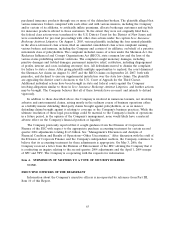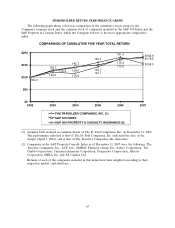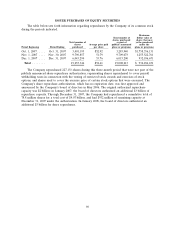Travelers 2007 Annual Report Download - page 69
Download and view the complete annual report
Please find page 69 of the 2007 Travelers annual report below. You can navigate through the pages in the report by either clicking on the pages listed below, or by using the keyword search tool below to find specific information within the annual report.on continuing to develop and enhance technology systems that support our business processes and
strategic initiatives in a cost and resource efficient manner. Some system development projects are
long-term in nature and may cost more than we expect to complete and may not deliver the benefits
we expect once they are complete. If we do not effectively and efficiently manage and upgrade our
technology portfolio, or if the costs of doing so are higher than we expect, our ability to provide
competitive services to new and existing customers in a cost effective manner and our ability to
implement our strategic initiatives could be adversely impacted.
If we experience difficulties with technology, data security and/or outsourcing relationships our
ability to conduct our business could be negatively impacted. While technology can streamline many
business processes and ultimately reduce the cost of operations, technology initiatives present certain
risks. Our business is highly dependent upon our employees’ ability to perform, in an efficient and
uninterrupted fashion, necessary business functions, such as Internet support and 24-hour call centers
processing new and renewal business, and processing and paying claims. A shut-down of, or inability to,
access one or more of our facilities, a power outage or a failure of one or more of our information
technology, telecommunications or other systems could significantly impair our ability to perform such
functions on a timely basis. In addition, because our information technology and telecommunications
systems interface with and depend on third-party systems, we could experience service denials if
demand for such service exceeds capacity or a third-party system fails or experiences an interruption. If
sustained or repeated, such a business interruption, system failure or service denial could result in a
deterioration of our ability to write and process new and renewal business, provide customer service,
pay claims in a timely manner or perform other necessary business functions. Computer viruses,
hackers and other external hazards could expose our data systems to security breaches. These increased
risks, and expanding regulatory requirements regarding data security, could expose us to data loss,
monetary and reputational damages and significant increases in compliance costs. As a result, our
ability to conduct our business might be adversely affected.
We outsource certain technology and business process functions to third parties and may do so
increasingly in the future. If we do not effectively develop and implement our outsourcing strategy,
third party providers do not perform as anticipated or we experience technological or other problems
with a transition, we may not realize productivity improvements or cost efficiencies and may experience
operational difficulties, increased costs and a loss of business. Our outsourcing of certain technology
and business process functions to third parties may expose us to enhanced risk related to data security,
which could result in monetary and reputational damages. In addition, our ability to receive services
from third party providers outside of the United States might be impacted by cultural differences,
political instability, unanticipated regulatory requirements or policies inside or outside of the United
States. As a result, our ability to conduct our business might be adversely affected.
Item 1B. UNRESOLVED STAFF COMMENTS
On July 23, 2004, the Company announced that it was seeking guidance from the staff of the
Division of Corporation Finance of the SEC with respect to the appropriate purchase accounting
treatment for certain second quarter 2004 adjustments totaling $1.63 billion ($1.07 billion after-tax).
The Company recorded these adjustments as charges in its consolidated statement of income in the
second quarter of 2004. Through an informal comment process, the staff of the Division of Corporation
Finance subsequently asked for further information, which the Company provided. Specifically, the staff
asked for information concerning the Company’s adjustments to certain of SPC’s insurance reserves
and reserves for reinsurance recoverables and premiums due from policyholders, and how those
adjustments may relate to SPC’s reserves for periods prior to the merger of SPC and TPC. After
reviewing the staff’s questions and comments and discussions with the Company’s independent auditors,
the Company continues to believe that its accounting treatment for these adjustments is appropriate. If,
however, the staff disagrees, some or all of the adjustments being discussed may not be recorded as
57


